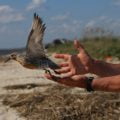Many of my fondest memories are from my time in protected natural areas – paddling past a caribou in Woodland Caribou Provincial Park, hearing the squealing of baby beavers within a lodge in Killarney Provincial Park and traversing mystical black spruce forests in Wabakimi Provincial Park.

But lifelong memories aren’t the only thing of value that these places give us. Protected areas – parks, nature reserves, conservation areas – provide countless benefits including clean air and water, healthy soils, wild foods, outdoor recreation, medicines and jobs that contribute billions of dollars to the Canadian economy every year. They increase our resilience to climate change and can sustain and strengthen Indigenous knowledge and value systems.

In 2010, Canada endorsed the United Nations target to protect at least 17 percent of the world’s land and inland waters by 2020. Less than 11 percent of Canada, including Ontario, is currently protected – well short of 17 percent and a far cry from the 50 percent protection that many conservationists deem necessary. All levels of government, industry and the public must step up in order to meet these international commitments. Additional protected areas may be derived from crown land, private conservation lands, and other lands with natural heritage value. Protected areas where Indigenous communities have the primary role in conserving culture and ecosystems are another promising opportunity for moving forward.
“A key reason to reach the 17 percent target is to provide safe havens for wild plants and animals” says Anne Bell, Director of Conservation and Education at Ontario Nature. Our planet has lost more than half its wildlife since 1970, making the call for protected places more urgent than ever. “Protected areas directly address the primary driver of extinction, habitat loss, which threatens over 80 percent of species at risk in Ontario and around the world.”

We must work with Indigenous communities to reduce this threat. Free, prior and informed consent of affected Indigenous peoples must be the cornerstone of protecting nature. Respectful dialogue and collaboration between Indigenous and non-Indigenous peoples are critical to successfully reach the 17 percent target.
Protected areas should be sufficiently large to support the biodiversity of the ecoregion being protected. Those areas must represent all ecoregions in Canada. Natural heritage protection should be the overriding priority with industrial activity prohibited. Protected places should be permanent and effectively managed for the long-term and be interconnected to support migration and genetic diversity of individual species.
Canada is blessed with abundant nature. We owe it to the world to play our part in protecting our wild spaces. We must seize this opportunity, not only to uphold our promise and invest in our shared future but because these places of incredible beauty are worthy of protection simply for their own sake.
In collaboration with a number of other organizations, Ontario Nature has crafted a Protected Places Declaration urging the achievement of the United Nations protected areas targets.
We invite you to sign the Protected Places Declaration at ontarionature.org/sign.
– Ron Corkum, an Ontario Nature board member, is a nature-lover with a keen interest in conservation issues.















